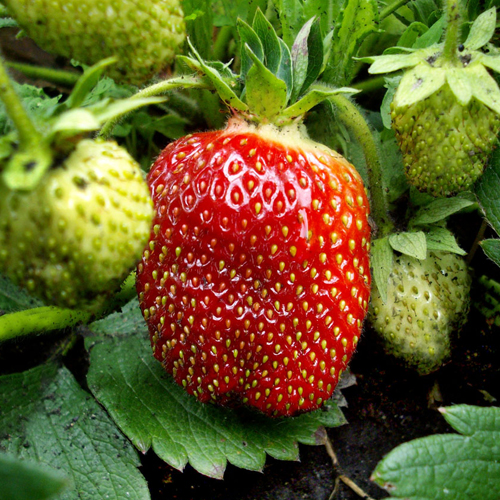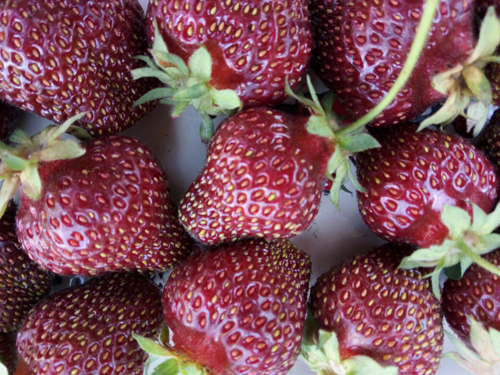Strawberry variety Ruby pendant
Ruby pendant is a domestic non-repairable variety of garden strawberries (strawberries) of medium ripening, universal use. It was bred in the early 80s at the All-Russian Research Institute of Genetics and Breeding of Fruit Plants named after IV Michurin, now the Federal State Budgetary Scientific Institution “Federal Scientific Center named after I.V. IV Michurin ". The author is A. A. Zubov. For breeding, varieties were used Zenga Zengana and Fairfax. In 1983, an application was filed for registration of the resulting plant in the State Register of Breeding Achievements of the Russian Federation, and after 5 years of testing, in 1988, the variety was included in it. Approved for cultivation in five regions of the country: Volgo-Vyatka, East Siberian, West Siberian, Central black earth, Central.

The plant is medium-sized, semi-spreading. Strawberry leaves are medium in size, dark green. Peduncles are located below the level of the leaves, under the weight of the fruit they are laid on the ground. Berries Ruby pendant of medium size, blunt-conical shape with a short neck. The skin is dense, dark red with a glossy shine, when fully ripe it acquires a characteristic cherry-raspberry hue. Achenes are yellow, pressed into the pulp to a medium depth. The pulp itself is dark red, very dense, rather juicy and aromatic. The berries are easily detached from the stalk, do not deform, and remain dry.
The taste of the variety is good, sweet, with a great deal of sourness. Due to their dense pulp, the fruits tolerate transportation well, therefore strawberries are very attractive for growing in order to sell fresh products to the market. The berries are universal in use, suitable for whole-fruit canning and any other processing, suitable for freezing, very good in their natural form. It is worth saying that the Ruby pendant does not differ in very outstanding taste, there are quite enough analogies on the market, and the dense pulp is no longer news.
The average weight of berries in the season can vary greatly, depending on the intensity of agricultural technology. The first fruits weigh about 20-30 grams, and specimens of more than 50 grams can form. However, by the end of fruiting, the berries become smaller to a level of 10-15 grams. The yield of the variety is average - 500-700 grams of fruits from one plant. Some sources claim up to 1 kg of strawberries per bush, but this is a very controversial figure. In principle, the Ruby pendant is responsive to intensive agricultural technology, but not even all "giants" of the strawberry market are capable of producing 1 kg of berries per plant, especially in the difficult climatic conditions of many regions of Russia when grown in open ground. Still, our hero is more suitable for cultivation in a summer cottage for personal consumption, you should not expect something supernatural from him. For business, it is better to take a closer look at other varieties that are more productive, especially since the choice is huge.

Strawberries are quite resistant to fungal diseases and spotting, but still need preventive treatments, especially during unfavorable periods, for example, during rainy seasons. The variety has excellent winter hardiness and frost resistance, calmly tolerates winter frosts down to -25 ° C, but shelter in any case will not hurt. But our hero has a problem with drought resistance - with an insufficient amount of moisture, the yield sharply decreases, the size of the berries decreases, and their taste qualities of strawberries can be seriously affected.
The ruby pendant perfectly adapts to any soil and climate, but requires sufficient attention to itself when grown in not particularly attractive conditions. So, on nutrient-poor soils, the pulp can be excessively dense, and the taste can be bland. And you can forget about high yields if you do not provide the plants with sufficient nutrition. It is worth noting that the taste of berries is highly dependent on weather conditions and agricultural technology, so you should pay enough attention to the plants if you want to get a tasty harvest.In agricultural technology, the variety is standard, it requires the most basic measures. The regularity and quality of care has a large impact on the productivity of strawberries.
Particular attention should be paid to watering. The ruby pendant is moisture-loving, but you should not overdo it - with waterlogging, the risk of fungal diseases will increase. In general, gardeners note that even in excessively rainy seasons, the taste of berries remains at a high level, but it is better to strengthen the prevention of diseases during such periods. It is highly advisable to mulch the soil in the near-root zone - this will prevent excessive drying out of the soil, especially if you do not have the opportunity to regularly water the plants. You should also pay sufficient attention to the removal of the whiskers, since they take up a lot of nutrition, as a result of which the yield decreases. Do not forget about the timely rejuvenation of the plantation as needed.

Let's summarize a little. The ruby pendant is quite a good variety that has earned enough respect for itself. However, at present it is no longer very popular and cannot compete with modern varieties. Indeed, this strawberry is not very fruitful, does not stand out for its excellent taste, and according to other characteristics it is not particularly outstanding. On the other hand, someone loves her very much and is not going to give her up. But if we leave aside personal preferences, we can say the following - now there are many more interesting varieties on the market, with more outstanding qualities. The choice, of course, is up to you. In any case, the Ruby pendant certainly cannot be called bad, it is quite reliable and quite good, depending on what goals of cultivation you are pursuing.








